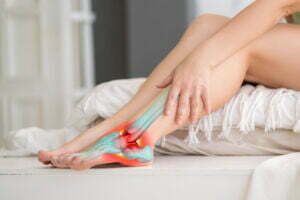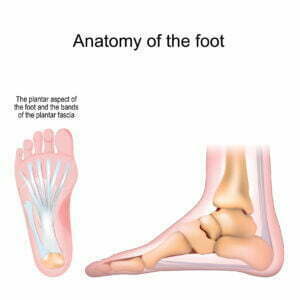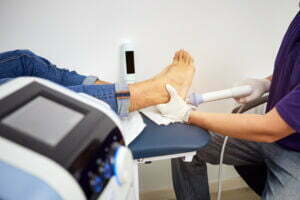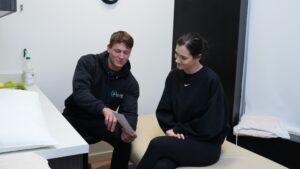
Have you heard of or ever suffered from plantar fasciitis? In simple words, it is the inflammation of the band of tissue (plantar fascia) at the bottom of your foot that runs from your heel to your toes. This causes pain on the bottom of your foot near the heel. This pain tends to be worse when you take your first steps in the morning or after a long period of rest.
Key Points
- Plantar fasciitis is the inflammation of the plantar fascia, tissue in the foot used during walking and foot movement.
- Plantar fasciitis can be caused by several factors, including type of shoes, foot structure, overuse, and types of walking surfaces.
- The main symptom of plantar fasciitis is heel pain.
- Treatment for plantar fasciitis usually does not require surgery and can be properly treated by physiotherapy.
The symptoms of Plantar Fasciitis
Increased pain after exercise:
The inflammation of the strong band of tissue that extends from your heel to your toes can worsen after exercising. This usually occurs because the tissue has been overstretched or develops tiny tears. Exercising repeatedly can injure or tear the plantar fascia.
A swollen heel:
When the thick band of tissue on the bottom of the foot is overextended or overworked, swelling occurs. The pain is typically described as a dull, stabbing pain in the heel.
Tightness in the Achilles tendon:
Tight Achilles tendons, which connect your calf muscles to your heels, can also cause plantar fascia pain.

Who is affected by Plantar Fasciitis?
Plantar Fasciitis affects approximately one in every ten adults. It is a frequent issue among active men and women aged 40 to 70. However, women have higher susceptibility than men, and obesity is a risk factor for developing symptoms.
It is not always clear why the inflammation occurs on the plantar fascia, but you may be more susceptible to develop symptoms if you:
- Recently started exercising on a hard surface regularly
- Exercise whilst having tightness in your calf
- Overstretching the sole of your foot when exercising
- Wearing shoes that don’t support your feet regularly
- Standing for prolonged periods of time
Complications
Ignoring plantar fasciitis can result in chronic heel pain that hinders your regular activities. You’re likely to change your walk to try to avoid plantar fasciitis pain, which might lead to further foot, knee, hip or back problems. Don’t let your plantar fasciitis get to this point!
What are the treatment options for Plantar Fasciitis?
Accurate diagnosis and treatment are critical for Plantar Fasciitis rehabilitation. This includes a thorough examination of the lower limb to aid the development of a diagnosis and the origin of the discomfort. The treatment attempts to reduce inflammation and pain, repair minor tears in the plantar fascia, enhance strength and flexibility, and allow you to resume normal activities.
At Synergy Rehab, our treatment will likely include massage therapy, stretches and strengthening for the lower limb and foot, and other methods such as taping to help support the appropriate structures.
Shockwave therapy is another effective treatment option for Plantar Fasciitis that we use across our clinics. This therapy is based on delivering low-energy or high-energy shock waves to a specific area. The shock waves create microscopic trauma, which triggers a healing response from the body. This process is thought to help promote healing in the plantar fascia. It can also overstimulate the nerves, resulting in decreased pain.
Top 5 tips to immediately reduce Plantar Fasciitis symptoms
Fortunately, there are ways to alleviate the discomfort of plantar fasciitis immediately. Here are our expert therapists top 5 suggestions:
Ice
Apply ice wrapped in a towel to the area of pain for up to 20 minutes several times throughout the day, or after exercise. Please don’t apply the ice directly onto your skin and this can cause ice burns! Your doctor or therapist may also recommend nonsteroidal anti-inflammatory medication.
Change how you exercise
It helps to keep the weight and stress off your foot, at least partially, while your plantar fascia is healing. Keeping active is important, but in a way that won’t aggravate your symptoms. Our therapists recommend:
- Changing to a more shock-absorbing exercise surface
- Applying athletic tape to your foot to support muscles and ligaments
- Decreasing distances and duration of walking or running
- Switching from jumping or running to swimming or cycling
Self-tissue release
Grab a golf ball or tennis ball and place your foot on top of it applying some pressure and rolling the ball backwards and forwards. This will help reduce tightness in the plantar fascia and reduce pain.
Stretching
Stretching is one of the best treatments for plantar fasciitis. Stretching should be focused on the plantar fascia and the Achilles tendon. One of our physiotherapists will show you stretching exercises that you can repeat at home several times a day. Along with stretching, the exercises can also strengthen your lower leg muscles, helping stabilize your ankle.
Gastrocnemius stretch
Using a wall for support, plant your affected foot flat on the floor behind you. Keeping this leg straight, lean forwards reducing the angle between your front foot and shin until you feel the stretch in your calf muscle of the leg planted behind you, ensuring your heel doesn’t come off the floor. Hold this for up to a minute.
Changing footwear
It is recommended to wear supportive footwear that has a shock absorbing insole and adequate arch support while healing from plantar fasciitis. Our therapists suggest that you:
- Avoid walking in bare feet or flip flops
- Switch to shoes with arch support or try heel cups
- Wear night splints to continue stretching your foot while you sleep

Plantar Fasciitis Treatment by Synergy Rehab
Plantar fasciitis can have a significant impact on your movement every day. Without treatment, this pain can hinder you from completing even the most basic everyday tasks. If you are experiencing any of the symptoms listed above, please contact one of our 11 locations right away so we can explore your options and get you back to normal. At Synergy Rehab, we’ve got your back.







